Michael and Peadar Kinane are farming just outside Horse and Jockey near Thurles, Co Tipperary. Just before Christmas 2019, Peadar turned his dry cows into a new cubicle shed. We got photographs that week just as the shed was nearing completion but before cows were turned in. Since then, Peadar has fitted sliding doors and tidied up a few loose ends. This week, we caught up with Peadar to hear how the cows settled into the new shed.
The cubicle shed was built adjoining existing sheds with a plan for a new milking parlour that is also under construction at the moment. An existing overground steel slurry tank adjoins the new shed, but there is also a slatted slurry tank running alongside the shed where cows are standing outside.
Most of the construction of the new shed was completed by Stephen Breen from John Breen Concrete and Ironworks in Tullaroan, Co Kilkenny, with help from Peadar when required. Peadar was all praise for the Breen team. Stephen’s son, John, makes the sheds. Easyfix supplied the mats and fitted them. Spillanes in Nenagh supplied the cubicles, O’Donovan Engineering provided some of the feeding gates, while Dairymaster supplied the scrapers. The approximate cost of the shed was €160,000 in total excluding VAT – this included the slurry tank, shed, concrete, barriers, etc.
Slanted feed barriers

Cows feed on two sides of the shed with three passages scraped and then an outside slatted tank standing area.
There are five bays on each side (10 in total) where cows can eat. There are 10 spaces in each bay and Peadar says eight cows eat at any one time. Two of the feed barriers can swing open on one side.
Cow mats

Four cow mats run right into the concrete brisket board.
Cow mats are supplied by Easyfix and have a mattress or foam underneath. At one stage, Peadar was thinking of fitting them himself but is delighted he got Easyfix to do it because a crew of five landed and had the majority of the work completed by 3pm that day. Peadar wanted a wide cubicle (46 inches) rather than the more standard 44.5-inch version, so there is an additional jigsaw strip in between the cubicle mats to allow for this.
There are 10 bolts keeping the mat in place and another three bolts in the strip. There is a four-year warranty on the mats but Peadar is very happy so far.
For dry cows, Peadar was scraping once per day and liming and they worked very well.
Dutch comfort cubicles
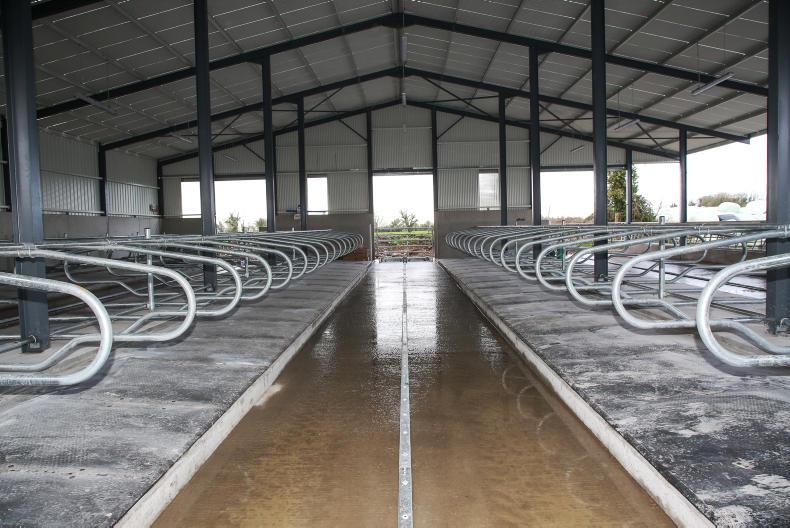
There are two double rows of cubicles and a single row along the back wall.
The cubicles have no legs – there is really only one bar plus the cubicles bolted to the uprights in the shed.
Peadar said he was worried at first that there wouldn’t be enough strength in the design but is more than happy and has seen the cubicles tested well over the last few months. He is very pleased that the design is up to the job. Peadar said another advantage of the design is that the cubicles can be made smaller, if required, for younger animals.
Concrete brisket board
This is an unusual feature that you won’t see in many sheds. Peadar is impressed with how it’s working and the fact that there is no lift or rise means there is no area to catch dirt but, more importantly, the cows respect it. Peadar said the cows will stay on the mats, almost irrespective of the neck rail.
Extendable gate
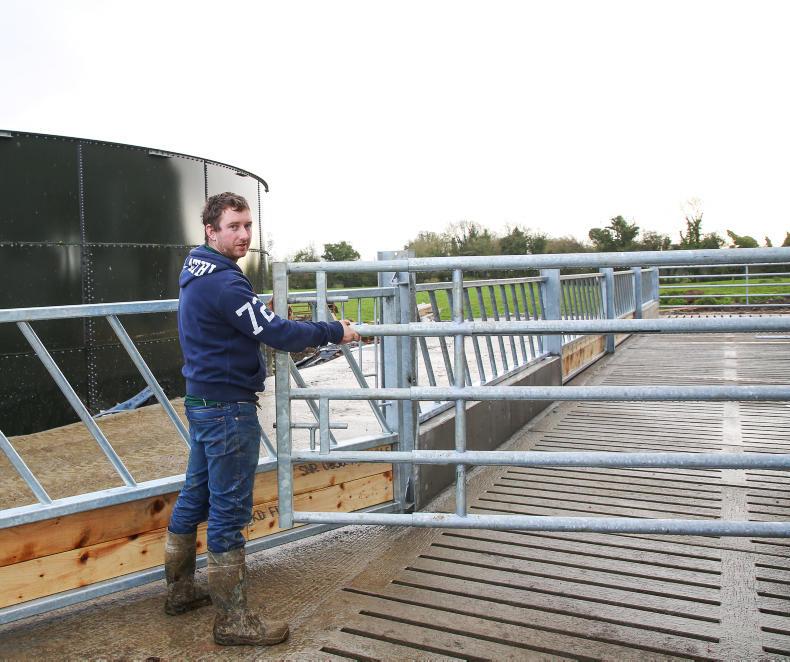
Peadar showing how the one gate can be extended to block off the slatted feeding area but also work as the gate for the shed.
Another nice feature is the extendable gate to make space so that the gate can be used to close off the feeding area but also the gate to the shed. It moves from 12ft to 15ft and Peadar said there is no loss of strength by doing this.
Clear sheeting
There is clear sheeting on both gables to let more light in. Peadar has doors up now at the far end and there is also one clear sheet in the doors.
There is space sheeting in the roof so that allows a certain amount of light in, but little or no rain.
Step at feed barrier
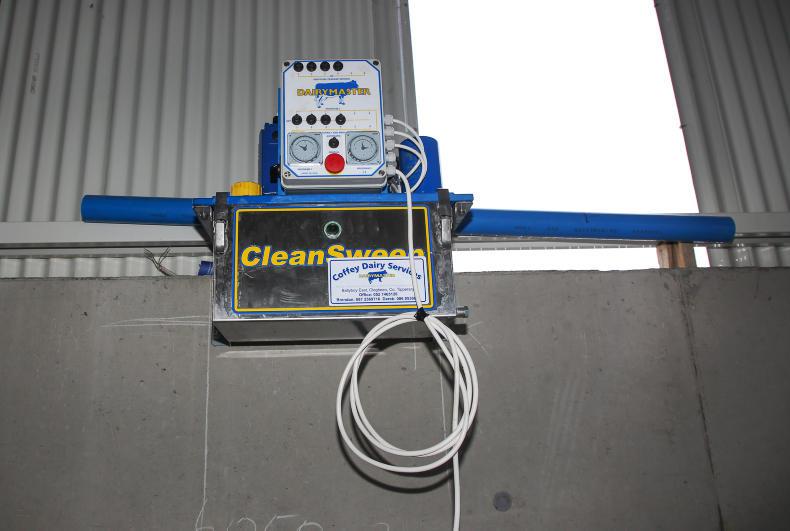
Dairymaster scraper control box.
There is a 2ft-wide step for cows’ front feet when they are feeding at the barrier in the shed. This allows the cows to feed but the scraper can work away and all they have to do is step over the scraper with their back legs.
Water trough
There is a water trough outside at the end of the shed and another one on a crossover passage at the opposite corner of the shed.
Downpipes

The water downpipes run down the H iron.
Downpipes are located along H-irons and buried in concrete which go to a clean drain and it’s water that could be collected.
Scrapers
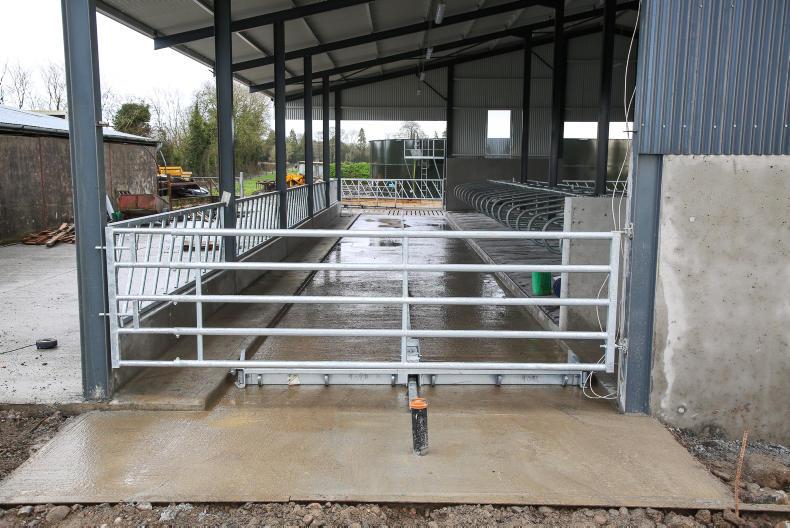
The scrapers park outside at the top of the shed so the cows are not standing on them in the shed.
Scrapers are parked outside the Kinanes’ shed so cows are not obstructed when walking.
When the photographer was at the shed in early December, the concrete was just poured outside.
Read more
The Breens' cows are coming home
New 90-cow cubicle shed in Cork
Michael and Peadar Kinane are farming just outside Horse and Jockey near Thurles, Co Tipperary. Just before Christmas 2019, Peadar turned his dry cows into a new cubicle shed. We got photographs that week just as the shed was nearing completion but before cows were turned in. Since then, Peadar has fitted sliding doors and tidied up a few loose ends. This week, we caught up with Peadar to hear how the cows settled into the new shed.
The cubicle shed was built adjoining existing sheds with a plan for a new milking parlour that is also under construction at the moment. An existing overground steel slurry tank adjoins the new shed, but there is also a slatted slurry tank running alongside the shed where cows are standing outside.
Most of the construction of the new shed was completed by Stephen Breen from John Breen Concrete and Ironworks in Tullaroan, Co Kilkenny, with help from Peadar when required. Peadar was all praise for the Breen team. Stephen’s son, John, makes the sheds. Easyfix supplied the mats and fitted them. Spillanes in Nenagh supplied the cubicles, O’Donovan Engineering provided some of the feeding gates, while Dairymaster supplied the scrapers. The approximate cost of the shed was €160,000 in total excluding VAT – this included the slurry tank, shed, concrete, barriers, etc.
Slanted feed barriers

Cows feed on two sides of the shed with three passages scraped and then an outside slatted tank standing area.
There are five bays on each side (10 in total) where cows can eat. There are 10 spaces in each bay and Peadar says eight cows eat at any one time. Two of the feed barriers can swing open on one side.
Cow mats

Four cow mats run right into the concrete brisket board.
Cow mats are supplied by Easyfix and have a mattress or foam underneath. At one stage, Peadar was thinking of fitting them himself but is delighted he got Easyfix to do it because a crew of five landed and had the majority of the work completed by 3pm that day. Peadar wanted a wide cubicle (46 inches) rather than the more standard 44.5-inch version, so there is an additional jigsaw strip in between the cubicle mats to allow for this.
There are 10 bolts keeping the mat in place and another three bolts in the strip. There is a four-year warranty on the mats but Peadar is very happy so far.
For dry cows, Peadar was scraping once per day and liming and they worked very well.
Dutch comfort cubicles

There are two double rows of cubicles and a single row along the back wall.
The cubicles have no legs – there is really only one bar plus the cubicles bolted to the uprights in the shed.
Peadar said he was worried at first that there wouldn’t be enough strength in the design but is more than happy and has seen the cubicles tested well over the last few months. He is very pleased that the design is up to the job. Peadar said another advantage of the design is that the cubicles can be made smaller, if required, for younger animals.
Concrete brisket board
This is an unusual feature that you won’t see in many sheds. Peadar is impressed with how it’s working and the fact that there is no lift or rise means there is no area to catch dirt but, more importantly, the cows respect it. Peadar said the cows will stay on the mats, almost irrespective of the neck rail.
Extendable gate

Peadar showing how the one gate can be extended to block off the slatted feeding area but also work as the gate for the shed.
Another nice feature is the extendable gate to make space so that the gate can be used to close off the feeding area but also the gate to the shed. It moves from 12ft to 15ft and Peadar said there is no loss of strength by doing this.
Clear sheeting
There is clear sheeting on both gables to let more light in. Peadar has doors up now at the far end and there is also one clear sheet in the doors.
There is space sheeting in the roof so that allows a certain amount of light in, but little or no rain.
Step at feed barrier

Dairymaster scraper control box.
There is a 2ft-wide step for cows’ front feet when they are feeding at the barrier in the shed. This allows the cows to feed but the scraper can work away and all they have to do is step over the scraper with their back legs.
Water trough
There is a water trough outside at the end of the shed and another one on a crossover passage at the opposite corner of the shed.
Downpipes

The water downpipes run down the H iron.
Downpipes are located along H-irons and buried in concrete which go to a clean drain and it’s water that could be collected.
Scrapers

The scrapers park outside at the top of the shed so the cows are not standing on them in the shed.
Scrapers are parked outside the Kinanes’ shed so cows are not obstructed when walking.
When the photographer was at the shed in early December, the concrete was just poured outside.
Read more
The Breens' cows are coming home
New 90-cow cubicle shed in Cork













 This is a subscriber-only article
This is a subscriber-only article








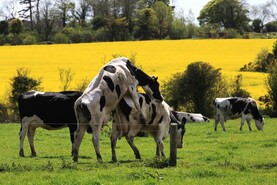
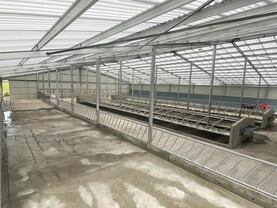
SHARING OPTIONS: